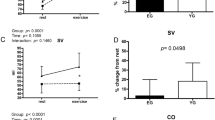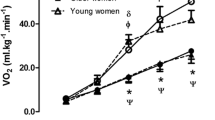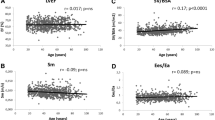Abstract
To assess the effects of age on left ventricular performance, multistage supine ergometer exercise radionuclide ventriculography (RNV) was performed in 92 normal subjects. The subjects ranged in age from 24 to 86 years and were free of cardiopulmonary disease and diabetes. Age-related changes in exercise duration, left ventricular end-diastolic volume (LVEDV), left ventricular end-systolic volume (LVESV), cardiac output (CO) left ventricular ejection fraction (LVEF), left ventricular dv/dt, systolic and diastolic time indexes of dv/dt, and peak systolic pressure/left ventricular end-systolic volume (PSP/LVESV) were analyzed at rest and during the peak exercise stage.
Age-related decrease in LVEDV and peak diastolic dv/dt were significant at rest. The time indexes of ECG R to peak systolic dv/dt and time of end-systole to peak diastolic dv/dt also were prolonged with age. Both maximum heart rate and exercise duration were shown to decline with age. No age-related difference was observed in LVESV, LVEF or PSP/LVESV either at rest or during exercise. However, the change of LVEF and LVESV during exercise was less in subjects aged 60 or more. These results indicate decreased left ventricular function during exercise in elderly subjects.
Similar content being viewed by others
References
Astrand I, Astrand P-O, Rodahl K: Maximal heart rate during work in older men.J Appl Physiol 14: 562–566, 1959
Granath A, Jonsson B, Strandell T: Circulation in healthy old men, studied by right heart catheterization at rest and during exercise in supine and sitting position, Acta Med Scand 176: 425–446, 1964
Julius S, Amery A, Whitlock LS, et al: Influence of age on the hemodynamic response to exercise.Circulation 36: 22–230, 1967
Dehn MM, Bruce RA: Longitudinal variations in maximal oxygen intake with age and activity.J Appl Physiol 33: 805–807, 1972
Gerstenblith G, Lakatta EG, Weisfeldt ML: Age changes in myocardial function and exercise response.Prog Cardiovas Dis 19: 1–21, 1976
Lakatta EG, Yin FCP: Myocardial aging: functional alterations and related cellular mechanisms.Am J Physiol 242: H927, 1982
Brandfonbrenner M, Landowne M, Shock NW: Changes in cardiac output with age.Circulation 12: 557–566, 1955
Strandell T: Circulatory studies on healthy old men.Acta Med Scand (Suppl) 4: 1–43, 1976
Rodeneffer RJ, Gerstenblith G, Becker LC, Fleg JL, et al: Exercise cardiac output is maintained with advancing age in healthy human subjects: cardiac dilatation and increased stroke volume compensate for a diminished heart rate.Circulation 69: 203–213, 1984
Port S, Cobb FR, Cleman RE, et al: Effect of age on the response of the left ventricular ejection fraction to exercise.New Engl J Med 303: 1133–1137, 1980
Konishi T, Koyama T, Aoki T, et al: Reversal of rest asynergy during exercise in patients with coronary artery disease.Jpn Heart J 30: 459–470, 1989
Konishi T, Ichikawa T, Koyama T, et al: Analysis of left ventricular volume using planar and single photon emission computed tomography of equilibrium radionuclide ventriculography.Jpn J Appl Physiol 18: 249–253, 1988
Massie BM, Kramer B, Gertz EW, et al: Radionuclide measurement of left ventricular volume: comparison of geometric and count-based methods.Circulation 65: 725–730, 1982
Kanstrup I-L, Ekblom B: Influence of age and physical activity on central hemodynamics and lung function in active adults.J Appl Physiol 45: 709–717, 1978
Astrand P-O, Cuddy TE, Saltin B, et al: Cardiac output during submaximal and maximal work.J Appl Physiol 19: 268–274, 1970
Schocken DD, Blumenthal JA, Port S, et al: Physical conditioning and left ventricular performance in the elderly: assessment by radionuclide angiocardiography.Am J Cardiol 52: 359–364, 1983
Mann DL, Denenberg BS, Gash AK, et al: Effects of age on ventricular performance during graded supine exercise.Am Heart J 111: 108–115, 1986
Willems JL, Roelant J, De Geest H, et al: The left ventricular ejection time in elderly subjects.Circulation 42: 37–42, 1970
Nichols WW, O’Rourke MF, Avoalio AP, et al: Effects of age on ventricular coupling.Am J Cardiol 55: 1179–1184, 1985
Iskandrian AS, Heo J: Left ventricular pressure/ volume relationship in coronary artery disease.Am Heart J 112: 375–381, 1986
Iskandrian A, Hakki A-H: Age-related changes in left ventricular diastolic performance.Am Heart J 112: 75–78, 1986
Linzback AJ, Akuamoa-Boateng E: The alterations of the aging human heart. I. Heart weight with progressive age.Klin Woschenschr 51: 151–159, 1973
Gerstenblith G, Frederiksen J, Yin FCP, et al: Echocardiographic assessment of a normal adult aging population.Circulation 56: 273–278, 1977
Osbakken MD, Boucher CA, Okada RD, et al: Spectrum of global ventricular responses to supine exercise: limitation in the use of ejection fraction in identifying patients with coronary artery disease.Am J Cardiol 51: 30–35, 1983
Tejada C: Distribution of coronary and aortic atherosclerosis by geographic location, race and sex.Lab Invest 18: 509–517, 1968
Gerstenblith G, Fleg JL, Van Tosh A, et al: Stress testing redefines the prevalence of coronary artery disease in epidemiologic studies.Circulation 62 (suppl III): III-308, 1980
Melin JA, Piret LJ, Vanbutsele RJ, et al: Diagnostic value of exercise electrocardiography and thallium myocardial scintigraphy in patients without previous myocardial infarction: a Bayesian approach.Circulation 63: 1019–1024, 1981
Author information
Authors and Affiliations
Rights and permissions
About this article
Cite this article
Konishi, T., Koyama, T., Aoki, T. et al. Influence of age on left ventricular performance during exercise in normal Japanese subject: Assessment by radionuclide ventriculography. Ann Nucl Med 4, 19–27 (1990). https://doi.org/10.1007/BF03165655
Received:
Accepted:
Issue Date:
DOI: https://doi.org/10.1007/BF03165655




